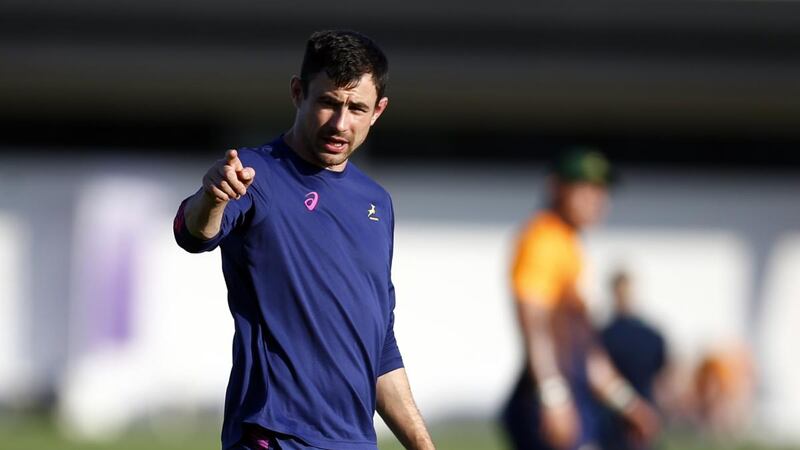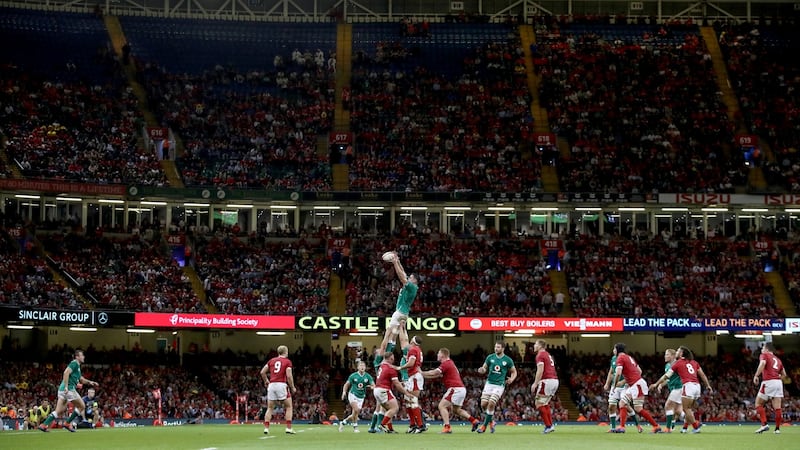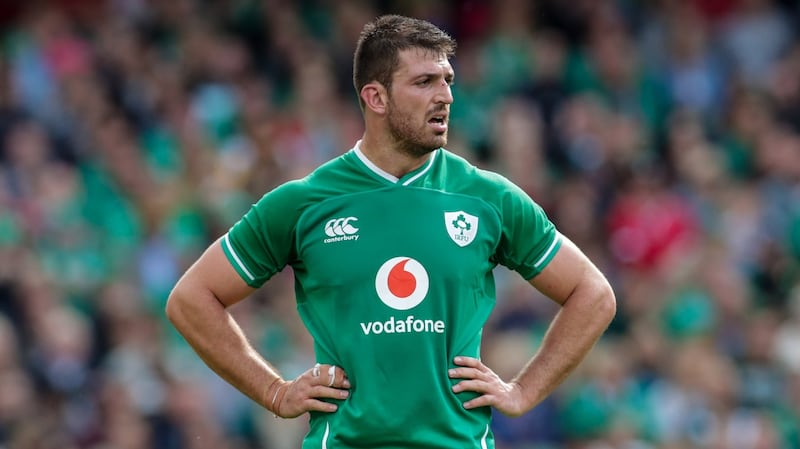Jerry Flannery has an intimate knowledge of South Africa's coaching team on a personal and professional level, specifically head coach Rassie Erasmus, defence coach Jacques Nienaber and attack and skills coach, the former Ireland international fullback Felix Jones, all three of whom he worked alongside at Munster during his time as forwards' coach.
On Saturday defending champions New Zealand will square off against South Africa in Pool B of the Rugby World Cup. Between them they have won five of the eight tournaments and if Ireland escape their pool they will face one or other of the southern hemisphere behemoths at the quarter-final stage.
Erasmus and Nienaber spent 16 months at Munster before returning to take up positions at the Springboks in November 2017, while Jones was co-opted into the coaching ticket, when in May he along with Flannery, decided not to renew their contracts with the Irish province.
In a short space of time Erasmus has transformed Springbok fortunes, culminating in winning an abbreviated version of the recent Rugby Championship. Flannery, who will be part of Eir Sport's Rugby World Cup panel of experts, is unsurprised by the development.
Erasmus succeeded New Zealander Rob Penney as Munster coach and introduced a more pragmatic style of rugby, patterns that are very familiar to the way that the Springboks play under his guidance.
Flannery explained: “They’re both brilliant coaches. When you look at the way New Zealand play and when you look at the way the Crusaders play, there is a higher skill-set required to play that rugby and when you have that skill-set, it would be foolish not to utilise it.
“I visited Rog [Ronan O’Gara] and I saw the Crusaders set-up; it was incredible. I can understand why Rob Penney tried to transplant that into Munster. But unfortunately when the players’ skill-set isn’t at the same level, it’s going to take a lot longer but that gameplan works.
“Rassie played a more pragmatic type of rugby which you’ll see with the Springboks now. If you’ve got to try to get from your try line to the opposition’s try line, you can’t carry and pass all the way up there; the likelihood is that if you make a mistake inside your own half, the opposition will have a good chance of scoring.

“Rassie’s is more of a territory based game. I’m aware you can’t only be that. When Rassie came into Munster, we were aligned in terms of the clarity of the gameplan, everyone knew what they had to do and it also took advantage of things at which Ireland are really good.
"You have a halfback like Conor Murray who can kick the ball really well. Tyler Bleyendaal had a fantastic year for us and he brought in Felix Jones who up-skilled a lot of lads who were naturally good from playing Gaelic Football and capitalised on their aerial ability."
The battle for the skies is an important facet of the modern game but Erasmus has made it a central tenet of the Springboks’ attacking blueprint. The acquisition of Jones in the run-up to the World Cup will make South Africa even more effective.
Flannery drilled down to the detail: “[Kicking] is not a conservative thing or a negative thing if you’re shifting pressure [even] if you don’t always get momentum being able to kick the ball and being able to contest the ball. Now, Felix was a fantastic player in the air so obviously it’s something when you’re coaching that you’ll gravitate towards.
“Felix put a huge emphasis on it when he played with Munster and all of the other areas around the kicking game. He didn’t just do the attack with Munster, he did our kicking game as well and that can start with how you pack a ruck to give your kicker the best option and ‘escorting’ when you’re receiving kicks.
“It can work with different tactics because sometimes you might want to field the ball, depending on the accuracy of your kicker; if you haven’t got as accurate a kicker you might focus on getting a real strong chase.
“In the Ireland versus Wales game at the [Aviva stadium], the results that they [Ireland] got from the actual tackle and then blasting through the ruck and turning the ball over was really effective. So Felix will take all those aspects and I’m sure he’s [introduced those to] training at the Boks as well.”
Flannery pointed to a change in emphasis in Ireland’s kicking game, less dependent on box-kicks, and instead happier to draw the defence forward and find the space in behind through the boot of the outhalf.

He explained that box-kicking off a static base is easy to read – the attacking team is aligned flat and offers no threat of running possession – and allowed opponents to withdraw their number eight and ‘edge defenders’ into the backfield.
It also permits opposing teams to clutter up the chasing channel to protect their catcher. He added: “If you look at the way Ireland have evolved, you want them kicking off 10. It’s dynamic, the opposition backline have to come up and they can put that long kick over to the far side.”
Flannery lavished praise on Nienaber, citing as one of his strengths his ability to communicate in simple terms exactly what he is looking for in the defence system and then develop it to the point where it becomes ingrained and very difficult to break down.
“Jacques Nienaber was one of the best I’ve ever come across as a defence coach. Starting off one of the fundamentals you want to get is your defence, get them conditioned, get your defensive system right and get the set piece right. After that you can start building layers. It takes time and I’m excited to see where Rassie goes with the Boks.”
Flannery, who won 41 caps for Ireland and was the starting hooker for four of Ireland’s five matches in winning the 2009 Grand Slam, offered an insight into Ireland’s lineout travails against England in the World Cup warm-up match at Twickenham and how they went about rectifying them in the two subsequent matches against Wales.
He explained that England compressed the lineout, allowed Maro Itoje to roam up and down and gave Ireland the option of winning ball at the front. However, Joe Schmidt's side went to the middle and the back, were slow on the way-in, laboured in their movement and that the calling at times failed to appreciate the space; essentially Ireland gambled and lost.
“Ideally you want to win the ball towards the tail, because if you’re mauling it opens up the blindside and if you’re going off the top, it’s a short pass and straight away you can get width. In the first Welsh game our lineout was massively improved but everything went to zone two; we just worked off that.
“If you watch the last Welsh game, Wales looked to step across the gap, slow things down [like England] and break the rhythm of the Irish lineout. There were probably a couple of poor calls to start with. When teams smell a small bit of blood they go we are going to put a lot of pressure on the lineout.
“What I would have said after the England game is Ireland need to have a plan to break down Tier 1 teams. If they are giving you ball at the front you have to have a plan to take it and still get to an edge. You might just have to play an extra phase before you can go wide.”
He made an interesting observation with regard to Welsh outhalf Dan Biggar's intercept in the second game. Rather than going off the top, James Ryan took the ball down in zone two to check the Welsh backline but because officials were not rigorous in policing offside, Biggar was able to sprint up-field and inveigle his way into the Irish passing channel.
Flannery maintained that getting Ryan to call lineouts was a good thing and a nod to the future but that “the most important thing is to be able to win the ball, win your own possession. You are better off taking the ball that you know you’re going to win rather than pursuing the 50-50 at the tail.
"If you watch how the Springboks defend lineouts they will always look to cut off the middle and the back and give you the front. You might as well win 100 per cent of the ball and learn to use it. The Scarlets and Leinster offer really good examples where they took a huge amount of ball at the front.
“Leinster would drop Seán Cronin, a real dynamic carrier, to the 15-metre mark; he’d hit, he’d carry, they would resource that ruck quickly and then the blindside winger would come in and move the ball. They would get to the edge then. If you win the ball and try to go to the edge [immediately], it’s just too slow.”
He subscribes to the notion of an ‘open’ World Cup in terms of the overall winner because New Zealand are not at their best but adds a codicil that when they are “no one else can live with them. There are a lot of teams who feel, Ireland are amongst them, they will get to the knockouts. From there it’s three games, cup rugby.”
Jerry Flannery on . . .
Jean Kleyn

“He came out for his first training session with Munster, most try to get up to speed and be friendly with everyone. Jean walked into the first lineout of the session, stood beside John Madigan turned and pushed him as hard as he could.
“When Jean Kleyn walks on the field the first thing he [aims] to be the most physical player. He does that really, really well. He’s an incredibly easy guy to coach, a pleasure to work with. He’s worked really, really hard on his handling game.
“The standard things that you see from Jean are his ability to impact rucks. Even if you haven’t won huge collisions your ability to move the opposition bodies a metre beyond the ball; that’s the equivalent of fast ball for you. It’s difficult to do because you are moving a mass but Jean is so big, he just moves it. It is a massive part of the game.
“In terms of taking opposition mauls apart he is like a huge battering ram. You never want to let the opposition’s maul get set, you want to try and disrupt it; splitting the jumpers. Jean is as good as anyone in Irish rugby at doing that.
“He adds huge ballast in the scrum, a work-on for him is keeping his shape at scrum time behind the tighthead but he adds massive weight. He has worked really, really hard on his handling in terms of receiving re-starts.
“Joe has spoken about trying to build in his attacking game. A work-on for him is his footwork and acceleration into contact. He should be a gainline winner for Ireland but that’s going to be the work-on and Joe has talked about adding that to his game, because it will strengthen Ireland’s game.”
Lineout calling
“He [the lineout caller] has got to be a coach [on the field], have a work ethic because that’s how he gets up to speed and he has to be able to function under pressure. Doing the analysis allows you to see why you are making errors. Having an understanding of [lineouts in general]; are the opposition a man watch team, are they a zonal team? [On your own ball] appreciating how movements work and what your hooker’s throwing speed is like [informs what you can do].
“The easiest thing is when your hooker has a quick throw and you are quick up in the air. If you’re throwing to Peter O’Mahony your hooker can just pelt it and he will get up and win the ball all the time. That gives you a massive advantage.
“I haven’t worked with James Ryan or Iain Henderson but I know that Pete can do that. I don’t think that JK [Kleyn] is as quick off the ground. The main thing is being a coach, taking responsibility for it. If you are the lineout caller then it is on you that we win our lineout ball.
“If James Ryan has done a good job there then you might be able to say to Jean [Kleyn], ‘we will see you working our contested lineout or you will be taking lineout mauls apart; the more that you can spread the ownership throughout the team the better.”
The art of lineout throwing
“In terms of the things I looked for when I was coaching and looking at hookers, I’d say pace on the throw, the same as pace on a pass, it just gives you so many more options.”
“Some teams will give you the front but others will say ‘no we are going to show you the tail here’. You have to have the confidence that your caller is able to look at you and go, ‘they are showing me the tail, there is a window of opportunity here’ where the throw has to have enough pace to get there.
The Ireland scrum
“Ireland’s scrum is phenomenal, one of the best scrums in the world. Greg Feek has done an incredible job. They have great alignment through their front five and all the backrow scrum really hard as well.”













